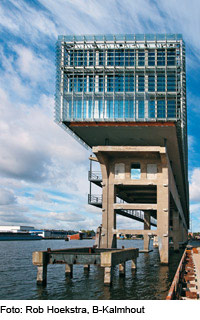"Kraanspoor" Office Building in Amsterdam

In the 1980s, Amsterdam’s port relocated to the west, and derelict shipyards and a dilapidated industrial compound were left behind. Urban planners envisioned a new commercial sector and saw no point in retaining existing structures. Thanks to the architect’s persistence, the crane equipment – dating to 1952 – that had been used to load ships was converted into an extraordinary building. “Kraanspoor” (crane track) consists primarily of steel and glass. The massive base is 270 metres long, stands 13 metres above the water’s surface and has a width of 8.50 m. The structural investigations determined that the sea side is more strongly dimensioned to compensate for the uneven loads caused by the cranes’ movement. Correspondingly, the three-storey, 13.5 m wide office complex rests asymmetrically on the base. Steel columns hoist the building 3 m above the bridge structure. Adaptations to the base were kept to a minimum. For this reason the vertical circulation was situated between concrete columns. The size of the office units flanking these circulation cores can be varied. The steel-frame structural system – accompanied by an ultra-thin floor slab system – is sufficiently lightweight to enable stacking three stories atop the base. The cavities in the ceilings provide sufficient space for the necessary piping and ductwork. The lightness of the structural members is carried over to the glazed, double-skin facade. The inner skin consists of floor-to ceiling French windows, the outer skin of sensor-controlled glass louvers. They open to an angle of 90 degrees and reduce the direct solar radiation as well as the glare from the water surface. When in a closed position, the louvers keep the elements at bay while facilitating natural ventilation of the spaces. The space between the facade’s two skins functions as climatic buffer zone. In order to avoid severe temperature fluctuation in the interiors, concrete core activation takes advantage of the large body of water. Catwalks provide access to the cavities in the concrete structure.
